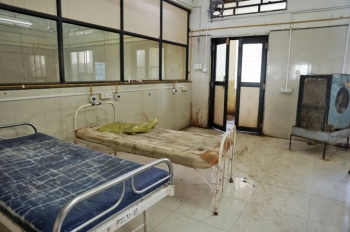
.png) Aarti
Aarti
.jpg)
The death of a large number of patients including newborns/children last month and early October at Dr Shankarrao Chavan Government Medical College and Hospital, Nanded, Maharashtra has triggered a political furore. The hospital authorities have reportedly reiterated that there was no shortage of medicines and the deaths occurred due to the deteriorating condition of patients that included children born with disorders.
Media reports indicate 65 patients were being treated at the Neonatal Intensive Care Unit (NICU) in the Nanded hospital against the sanctioned strength of 24 beds when 11 infants died at the NICU between September 30 and October 1. Of the deaths that occurred in NICU, eight (infants) were referrals who were shifted here at a very critical stage and weighed below 1,000 grams. Another ward -- the Paediatrics Intensive Care Unit (PICU) -- with a capacity of 31 beds was treating 32 patients but no patient was denied admission. Considering both the wards, a total of 156 children were admitted of which 96 were in the PICU and NICU together when the deaths occurred.
According to Congress leader Ashok Chavan, even as over 60 infants were admitted to the NICU, there were only three nurses to take care of them. There was just one warmer which was used to treat three babies at a time. The Nanded hospital’s acting dean has filed a defamation suit against a Shiv Sena MP, who had come to inspect the hospital, for telling him to clean a dirty toilet -- a video of which has gone viral, sparking an outrage. The ongoing probe by the three-member committee formed by the State Government is expected to unravel more details about the deaths of patients.
Dealing with a suo motu PIL, and finding that at least 47 posts of professors, etc. and about 50 percent of the posts of senior residents were vacant in the Nanded medical college and hospital respectively, the Bombay High Court has maintained that there shouldn’t be a single vacant post of a doctor and paramedic in public hospitals. The division bench also dwelled upon reduction in the budgetary allocations for Health after 2021-2022, including medicine procurement mechanism for the hospitals, sanitation inside and outside hospitals and sought to know the causes of deaths in the two hospitals and the steps being taken.
The Indian healthcare system, probably the largest in the world, is State subject and the primary responsibility, be it filling the vacancies of health personnel or managing Government hospitals, lies with the State Government. According to latest official statistics, there is a vast network of 1,57,819 Sub Centres (156101 rural + 1718 urban), 30,579 Primary Health Centres (25140 rural + 5439 urban), 5,951 Community Health Centres (5,481 rural + 470 urban), 1224 Sub-divisional Hospitals, 764 District Hospitals and 307 Medical Colleges. There are about 1.3 million allopathic doctors and 0.8 million AYUSH doctors (doctor-population ratio at 1:834) including 3.4 million nurses/auxiliary nurse and midwives. As per established norms, a PHC in rural areas is to be established for a population of 20,000 (in hilly and tribal areas) and 30,000 (in plains); SC for a population of 5,000 (in plain) and 3000 (in hilly and tribal area); CHC for a population of 1,20,000 (in plain) and 80,000 (in hilly and tribal area). Similarly, District Hospital, Sub-District Hospital and First Referral Unit-community Health Centres provide secondary care services. The Government funded health insurance -- the Ayushman Bharat initiative -- covers over 500 million people with free medical treatments. Over 40 million people have already availed services in a cashless and paperless manner. This is said to have saved nearly 7 billion USD already.
However, there have been recurring instances where the health system has faced serious challenges. Many once-renowned Government hospital buildings seem to show signs of age and are at risk of collapse. When it rains both the wards and the patients' beds get wet. Government hospitals are sometimes forced to admit twice the number of patients. Not long ago, 150 children died in Bihar’s Muzaffarpur due to endemic Acute Encephalitis Syndrome. 105 infants died at Rajasthan’s Kota, 111 infants Gujarat’s Rajkot while 85 deaths were recorded in Ahmedabad.
Well, the report of a government panel in Rajasthan revealed that a majority of infants at the Kota hospital died due to hypothermia and the ICU did not have warmers to maintain the infant body temperature at its ideal of 36.5 degrees Celsius. Further, of the total 28 nebulisers, 22 were dysfunctional, there were no para monitors or oximeters to monitor oxygen levels, there was no oxygen pipeline and the ICU hadn’t been fumigated for months. A central team sent by the Union Health Ministry to probe the high number of infant deaths at the Kota hospital reportedly found heavy shortage of several life-saving equipment in the hospital, besides shortage of medical personnel, including doctors, nurses and paramedics, in comparison to high patient load. While the hospital had nearly 220 percent occupancy rate, there was an acute shortage of medical personnel — up to 80 per cent — given the heavy patient load.
With babies sometimes born in the country in places where the resources to look after them are unavailable, health experts have suggested the need for putting in place a neonatal emergency transport network. Simply put, neonatal networks aim at providing transport and delivering of critical care services to newborn and extreme pre-term babies by a multidisciplinary team of experts using the most advanced technology in order to provide the highest standard of care to the baby. It has also been recommended that a public-private partnership model that will see existing district hospitals getting attached to private medical colleges can help in providing timely medical in the neighbourhood.
All said and done, there is an imperative need to effect urgent reforms including filling up of vacancies at all Government hospital across the country to prevent the recurrence of Nanded-type incidents. More because, those with no financial means can receive timely treatment.